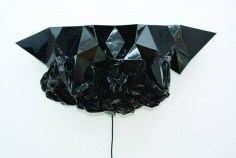CHARLOTTE BECKET
Ink Blot
source: highlike
Work: Polished forms collapse and resume composure, dark mirrored surfaces reflect the environment around them. These works are kinetic sculptures that move slowly, sometimes imperceptibly, performing gestures born from the banality of the human condition. Their looping, rhythmic motion transforms the sculptures from motorized machines to figural abstractions or landscapes. Rigid symmetrical forms are punctuated with bulging rifts that slowly swell, either in a moment of expansion or exhale. As the forms shift and redirect light they become hallucinogenic and unstable, subsisting in perpetually fracturing and rearranging circumstances. These bloated bodies creak and labor, endlessly moaning and muttering to them selves in an unresolved internal dialogue.
Work: This work explores the territory between a Sisyphean futility and jubilant optimism. Because the machines are all driven by a simple motor, they loop and cycle through their work endlessly, often moving very slowly working to perform and then undo the same task. As they move, they work both in a state of futility and in an unconscious celebration of themselves. Some of the earlier machines do very specific things; the machine in Fixing the Cowlick (2005) repeatedly presses down and curls up the same piece of paper. Other pieces like Cyclops (2009) have a giant gaping iris/sphincter that opens and closes, staring and breathing. Similarly, Curdle II (2011) takes the form of a single heap with two mouths gaping back and forth at each other, engaged in a perpetually unresolved discourse. In the more current pieces, mechanized structures fitted with lenses and lights cast mirage-like projections of themselves on the walls of the space. These self-surveillance projected images are in contrast to the physical form of the sculptures. The organized cage-like scaffolding of Infinitas Via (2012) projects a hallucinogenic image of endless travel or escape down an infinite road. In the piece Light (2013), using reduced means; cardboard boxes, light bulbs and lenses, a rudimentary projection device is created wherein the light source is simultaneously the image. The extroverted mass projects its interior mechanism to create its own atmosphere, prompting a dialogue between the rational topography and its dislocated environment. The projected imagery builds in superimposed layers around the space. As light leaks and pools across the façade of the central form it leaves pinhole after-images and sweeping slivers of light that take over and complicate the bulky mass. The mechanization in these pieces work in opposition to what we demand of the mechanized world around us. It seeks to offer something else, something that is slow and inefficient but more closely aligned with our selves.
Photographer: Charlotte Becket
.
.
.
.
.
.
.
source: mutualart
Charlotte Becket is a British visual artist who was born in 1978. Several works by the artist have been sold at auction, including ‘Oliko aamu’ sold at Hagelstam ‘Modern & Design auction’ in 2013. There have been Several articles about Charlotte Becket, including ‘GOTHAM ART & THEATER’ written by Elisabeth Kley for artnet in 2009.
.
.
.
.
.
.
source: gazelliarthouse
The New York based artist, Charlotte Becket, explores the world of objects in a personal and playful way, analysing the relationship between forms, textures and materials; how things are made and how their parts join together.
Many of her sculptures are robotic structures, made of ubiquitous things from everyday life, such as found objects, commercial materials and garbage. They are machines driven by a simple motor, where the materials, assuming multiples identities, are transformed from their original appearance into something else. The works begin as seemingly inanimate objects but close inspection shows them expanding and contracting as if breathing thus making a direct reference to change and movement.


